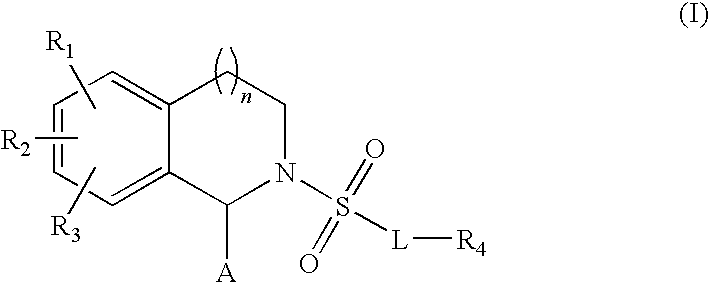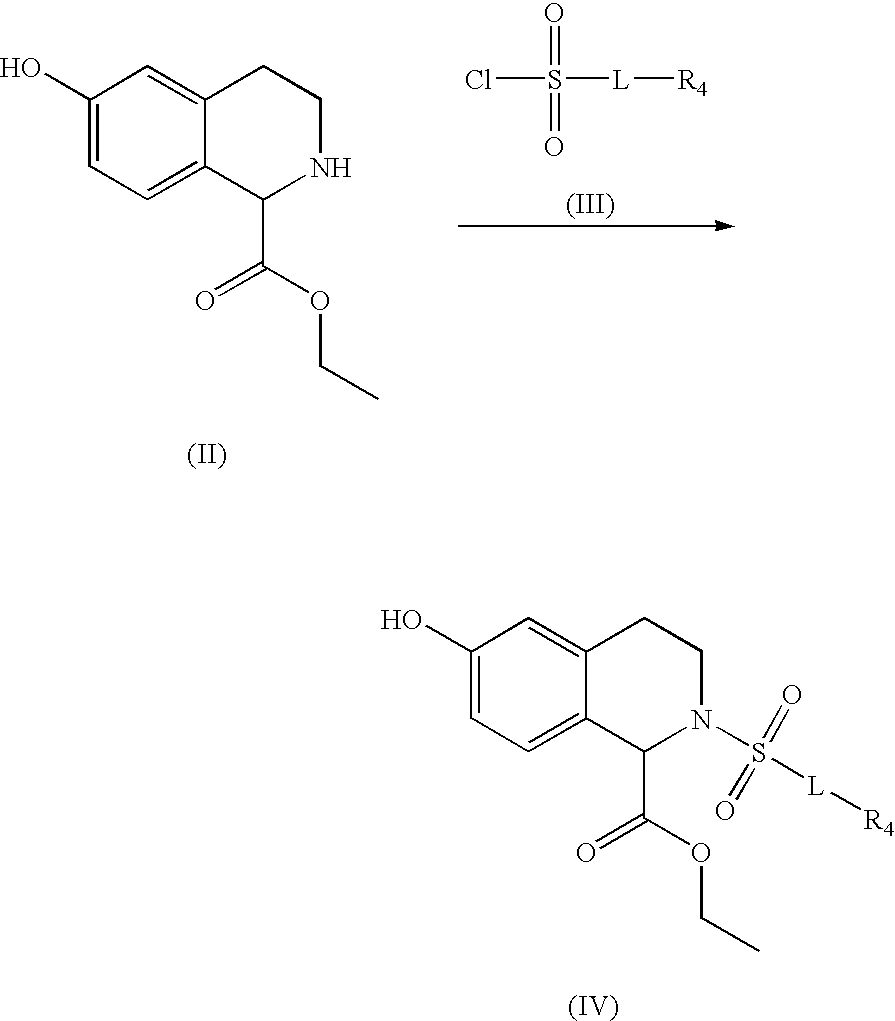Substituted tetrahydroisochinolines as MMP inhibitors, related production method and use as medicine
a technology of mmp inhibitors and substituted tetrahydroisochinolines, which is applied in the direction of antibacterial agents, drug compositions, immunological disorders, etc., can solve the problems of unstable angina pectoris, unstable myocardial infarction or stroke, and plaque instabilities
- Summary
- Abstract
- Description
- Claims
- Application Information
AI Technical Summary
Benefits of technology
Problems solved by technology
Method used
Image
Examples
example 1
Preparation of Exemplary Compounds
Exemplary compounds 3 and 4:
3: 2-[4-(4-Fluorophenoxy)benzenesulfonyl]-6-[3-(4-methylpiperazin-1-yl)propoxy]-1,2,3,4-tetrahydroisoquinoline-1-carboxylic acid hydroxamide;
4: 2-[4-(4-Fluorophenoxy)benzenesulfonyl]-6-[3-(4-methylpiperazin-1-yl)propoxy]-1,2,3,4-tetrahydroisoquinoline-1-carboxylic acid;
3A: 4-Fluorophenoxybenzenesulfonyl chloride;
[0174]16.1 g (0.138 mol) of chlorosulfonic acid are slowly added dropwise to a solution of 13.05 g of 4-fluorophenoxybenzene (0.069 mol) cooled to 0° C. After the addition is complete, the mixture is stirred at room temperature for a further 4 hours. For work up, 50 ml of dichloromethane are added, and the mixture is washed once with H2O. The aqueous phase is separated off and extracted twice more with 50 ml of dichloromethane each time. The combined organic phases are dried with MgSO4 and concentrated, resulting in the title compound as a colorless solid. Yield: 11.03 g; 60%.
3B: Methyl 2-[4-(4-fluorophenoxy)benze...
example 2
Catalytic Inhibition of Gelatinase B (MMP-9) in Human Serum by Synthetic MMP Inhibitors
[0217]Freshly isolated human serum was shock-frozen in the desired volume in liquid N2 and then stored at −80° C. For the catalytic inhibition of MMP-9 in human serum, the appropriate parts by volume of human serum were thawed at room temperature. 100 parts by volume of undiluted, freshly thawed human serum were mixed with 1 part by volume of test substance, thoroughly mixed and incubated at 37° C. for 1 h. The test substances were dissolved in 100% dimethyl sulfoxide, and a 10 mM stock solution was prepared. For dose-effect plots, the test substances were tested in final concentrations of from 200 μM to 0.001 μM for their catalytic inhibition of MMP-9 in human serum. The final concentration of DMSO in the reaction solution was 1% in each case.
[0218]Active MMP-9 from the reaction solutions described above was determined with the aid of a MMP-9 activity assay system (Amersham Pharmacia Biotech Euro...
example 3
Determination of the Solubility by Means of a CLND (Chemo Luminescence Nitrogen Detector)
[0261]For the thermodynamic solubility measurement, 1 mg of solid substance is taken up in 250 μl of PBS buffer (sodium phosphate 10 mM; pH 7.4; 0.9% NaCl isotonic salt concentration) and mixed, and the suspension is shaken at room temperature for 16 hours. The solution is then centrifuged at 14 000 rpm for 5 minutes. The solution is removed from the pellet and filtered through a syringe filter (0.45 μm pore size). The presence of a pellet is checked in order to ensure that a saturated solution was present. The filtered clear solution is analyzed by HPLC.
[0262]The dissolved amount of substance is quantified using a generic chromatographic method:
[0263]Either a calibration line derived from DMSO stock solutions (1-500 μM) of the appropriate substance is used to quantify the corresponding signal in the UV (254 nm) chromatogram of the solubility sample, or the quantification is undertaken via the p...
PUM
| Property | Measurement | Unit |
|---|---|---|
| temperature | aaaaa | aaaaa |
| temperature | aaaaa | aaaaa |
| temperature | aaaaa | aaaaa |
Abstract
Description
Claims
Application Information
 Login to View More
Login to View More - R&D
- Intellectual Property
- Life Sciences
- Materials
- Tech Scout
- Unparalleled Data Quality
- Higher Quality Content
- 60% Fewer Hallucinations
Browse by: Latest US Patents, China's latest patents, Technical Efficacy Thesaurus, Application Domain, Technology Topic, Popular Technical Reports.
© 2025 PatSnap. All rights reserved.Legal|Privacy policy|Modern Slavery Act Transparency Statement|Sitemap|About US| Contact US: help@patsnap.com



